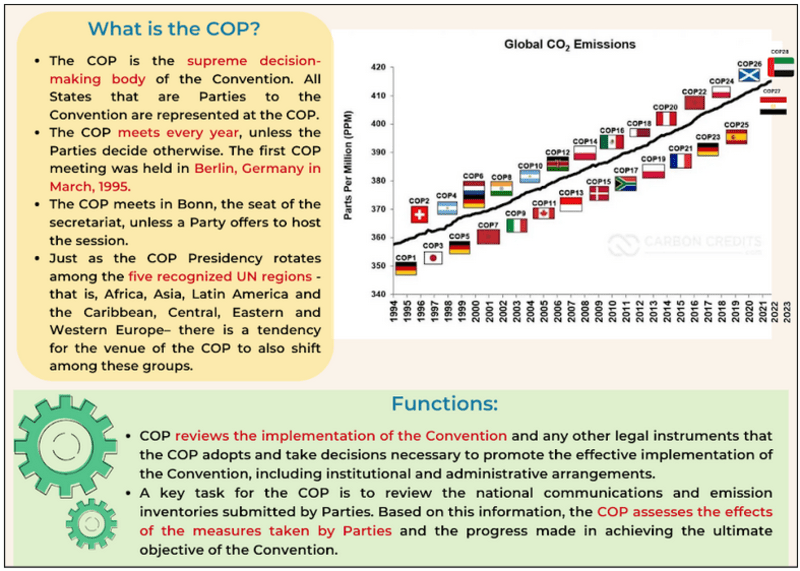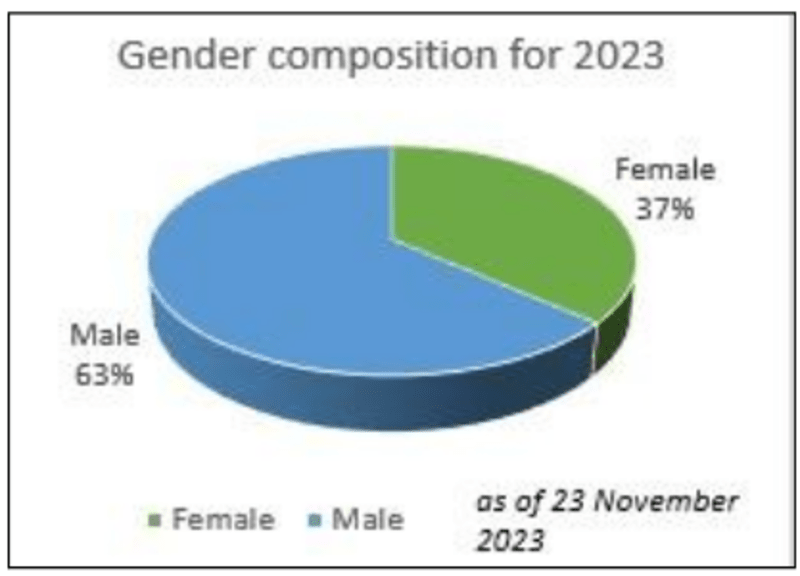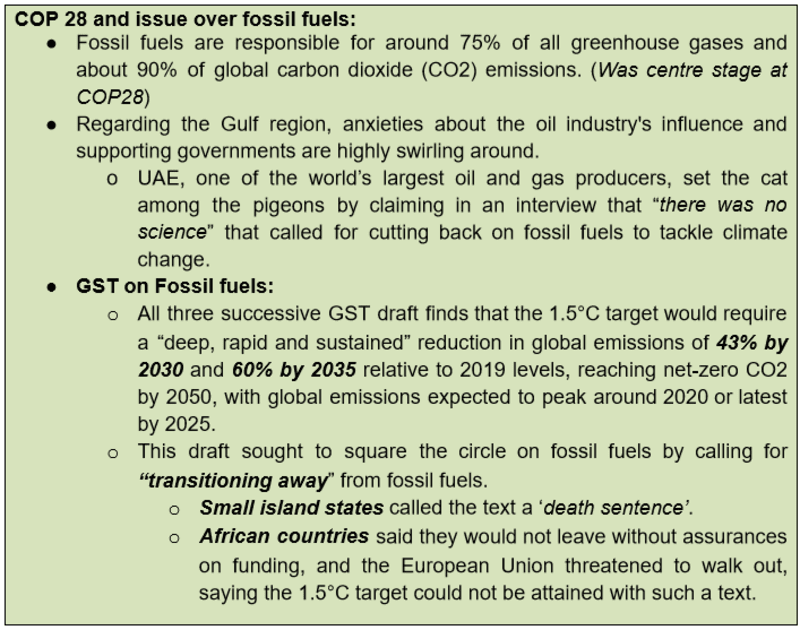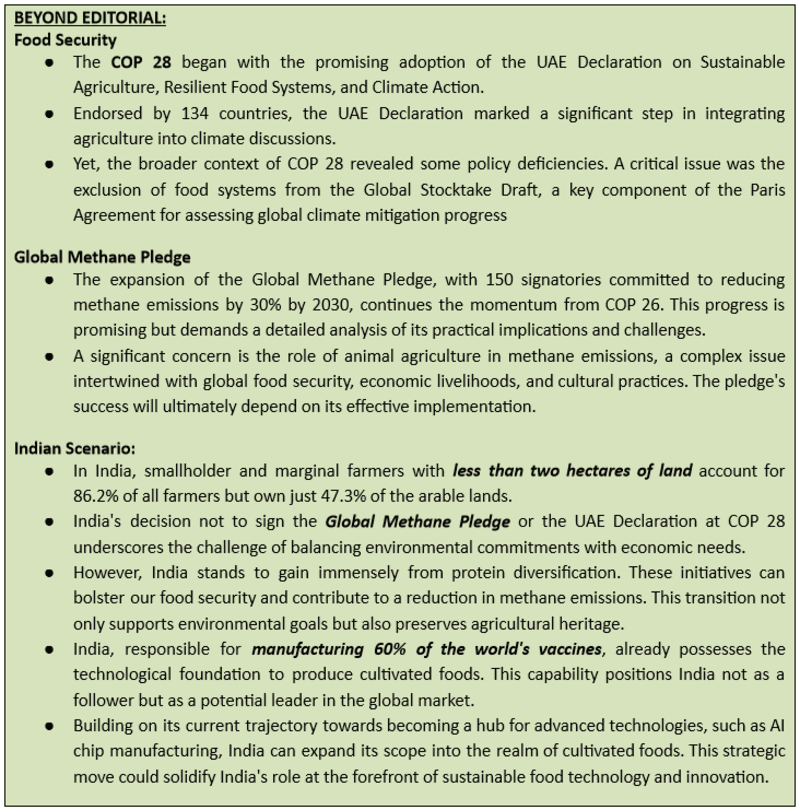COP28 — many slippery slopes ahead
“Climate change is the greatest threat to our existence in our short history on this planet. Nobody’s going to buy their way out of its effects.” - Mark Ruffalo
Relevance: GS III (Environment)
- Prelims: COP 28; Paris Agreement; Kyoto Protocol; Global Stocktake (GST); Nationally Determined Goals;
- Mains: Climate Change (Issues and Challenges) – Mitigation; Adaptation and Implementation;
Why in the News?
Recently held, COP28 in Dubai (UAE) was a milestone event slated to take up the first five-year Global Stocktake (GST) concerning goals set under the Paris Agreement to combat the climate crisis.

Election and Membership:
- The climate change institutional framework includes the 3 bureaux of the governing and subsidiary bodies and 17 constituted technical bodies established under the Convention, the Kyoto Protocol and the Paris Agreement.
- Each year, members and their alternates are elected or appointed to these bodies based on nominations from United Nations regional groups or other constituencies to achieve gender balance in the membership of these bodies.
- Information on the UNFCCC electoral process, membership of bodies, gender balance, and other details about these bodies is available below.

About COP 28:
- On 13 January 2023, the UNFCCC Secretariat announced that UAE has been appointed COP 28 President-Designate.
- Both the previous COP 27 Egyptian Presidency and the present COP 28 UAE Presidency conveyed to engage governments at the ministerial and technical levels to lay the groundwork to deliver a successful COP 28 that drives global transformation towards a low-emission and climate-resilient world, fosters ambitious climate action and facilitates implementation, including the related support.

- The focus of COP 28 was on four paradigm shifts:
- Fast-tracking the energy transition and slashing emissions before 2030;
- Transforming climate finance by delivering on old promises and setting the framework for a new deal on finance;
- Putting nature, people, lives, and livelihoods at the heart of climate action; and
- Mobilizing for the most inclusive COP ever.
Global Stocktake (GST) and COP 28:
- The Global Stocktake (GST) is a comprehensive assessment of the world's progress on climate action.
- Anchored in Article 14 of the Paris Agreement, it is intended to inform Parties to the Agreement on their progress against its goals, including but not limited to limiting global temperature rise to 1.5°C.
- The first Global Stocktake (GST) of implementing the Paris Agreement was concluded at COP 28.
- Each stocktake is a two-year process every five years to assess the world’s collective progress towards achieving its climate goals.
- The first Global Stocktake (GST) takes place at the mid-point in implementing the 2030 Agenda for Sustainable Development and its SDGs, including Goal 13 (climate action).
- Significance of GST:
- It monitors the global climate change mitigation and adaptation progress, translating into implications for countries signatories to the Paris Agreement.
- After presenting at COP, countries must confer on how to respond by agreeing and delivering the ’political outcome’ of the GST.
- Countries are expected to update and increase the ambition of their NDCs until 2025 and submit their first ‘biennial transparency report’ (BTR1), which will help track progress.
- The GST is thus crucial to the so-called ‘ratcheting up’ mechanism that is a key part of the process for meeting the Paris Agreement goals.
What were the key findings of the Global Stocktake (GST) Report?
Severe heat waves, droughts, forest fires, floods, and extreme rainfall are already witnessed more frequently worldwide, along with possible irreversible melting of polar and glacial ice and rising sea levels. The urgency to rein in greenhouse gas (GHG) emissions causing climate change was top of the agenda in Dubai 2023.
(1) Mitigation goal: The report highlights an estimated ‘emissions gap’ of 20.3–23.9 billion tonnes of carbon dioxide equivalent (38–45% of global annual emissions): this is the difference between where emissions are heading under current NDCs and where emissions should be by 2030 for the world to be on track with a 1.5°C pathway.
- What needs to be done?
- Parties are expected to adopt more ambitious mitigation targets in their updated NDCs, including phasing out all unabated fossil fuels and ending deforestation.
- We must identify new cost-effective opportunities to cut emissions, such as green industrialization.
- Need for implementing collective and participatory decision-making processes to reduce the disruptive consequences for jobs and communities of transitioning away from fossil fuels.
(2) Adaptation goal: The report highlights the most adaptation action and support as “fragmented, incremental, sector-specific and unequally distributed across regions”.
- What needs to be done?
- Parties need to enhance transparency when reporting on adaptation efforts and to ensure that action is driven by local contexts and populations, especially traditionally marginalized groups such as women, youth, and Indigenous Peoples.
- Need to rapidly scale up finance for adaptation, including arrangements for addressing loss and damage.
(3) Implementation and finance: The report shows that despite increases in climate finance from developed to developing countries, shortfalls remain in the mobilization and provision of such finance.
- What needs to be done?
- The need to transform the global financial system can be achieved by strategically deploying international public finance to support climate action in developing countries.
- Need to simplify access to international climate funds and create more enabling conditions by mitigating financial risks, lowering investment costs, and creating more investable products.
- Accelerated technology transfer is identified as a key means of implementation.
How the draft presented at COP 28 have loose definitions?

- Loopholes: The final draft favored the industry and rich developed countries with advanced technologies.
- While calling for a phase-down of “unabated” coal power, the door was left open for “low-carbon fuels”, “low-emission” technologies, “low-carbon hydrogen”, and “transitional fuels” (widely used in Europe and the United States to describe natural gas) — all terms with very loose definitions.
- These loopholes can prolong the production and use of fossil fuels.
- Unclear on Emissions: It also mentioned Carbon Capture, Utilisation, and Storage (CCUS), which has not achieved commercial viability and whose eventual emissions savings are unknown.
- On emission reductions and shift to clean energy, the draft also did not adequately refer to equity or Common but Differentiated Responsibility (CBDR), possibly under pressure from the U.S. looking to treat all countries on a par.
- Unrecognized Financial Support: The final draft also did not take the issue of financial support by developed countries further, causing much anguish to vulnerable climate-sensitive countries.
- The draft expressed concern that the earlier commitment of $100 billion per year by 2020, however inadequate, had not been met.
- It repeated the global Stocktake reports (GST) estimation that developing countries needed about $5.8-$5.9 trillion for the pre-2030 period, with adaptation alone requiring $215-$387 billion per year and clean energy transition requiring about $4.3 trillion per year, both until 2030.
- Yet, no fresh targets were mentioned in the draft, not even for the new Loss and Damage fund formally set up on the first day and gathering pledges for a meager $470 million.
Conclusion:
We are finally moving towards acknowledging that climate change is only one component of a larger ecological challenge the world is facing and that intervention in one domain has feedback effects on other domains. There is no alternative to adopting a cross-domain and cross-disciplinary approach to resolving such deeply interconnected challenges. COP28 has at least pointed us in the right direction.

Mains PYQ
Q. Describe the major outcomes of the 26th session of the Conference of the Parties (COP) to the United Nations Framework Convention on Climate Change (UNFCCC). What are the commitments made by India in this conference? (UPSC 2021)
Q. 'Clean energy is the order of the day.' Describe briefly India's changing policy towards climate change in various international fora in the context of geopolitics. (UPSC 2022)

